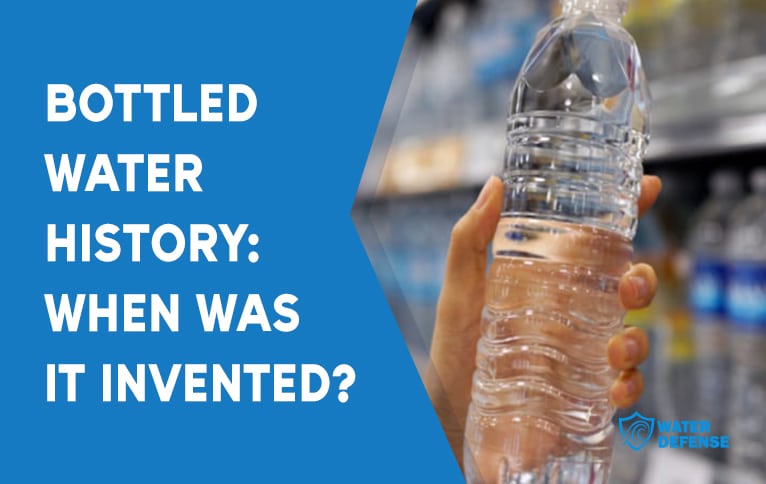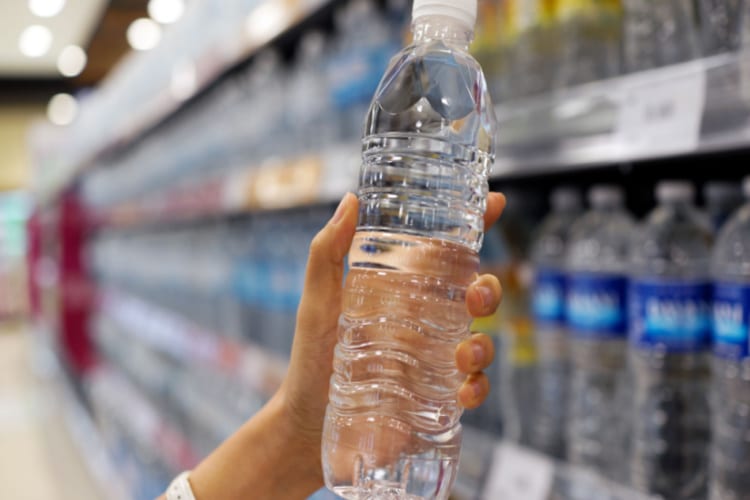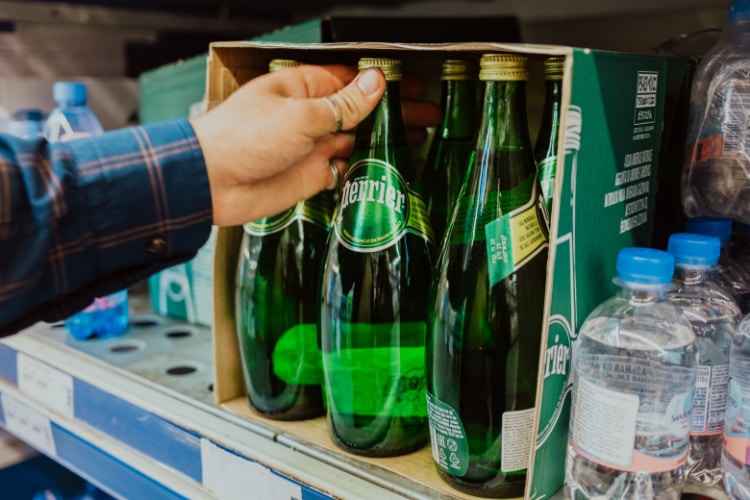Bottled water may seem like it has always been in our lives. It occupies the most space in vending machines, sponsors athletic events, and contaminates our oceans.
But when did it all begin?

In this article, we’ll delve into the history of bottled water. We’ll answer all your questions, such as when water was first bottled, by whom, when it popped up on the market in the US, and how it became popular.
When Was Bottled Water Invented?

Although people have stored their water in different containers since the beginning of civilization, the first commercial water bottling happened in 1622 in the United Kingdom.
Unfortunately, historical sources don’t provide a single name for the inventor of this practice — the invention is attributed to local grocers.
In the early 17th century, Europeans discovered the therapeutic and medicinal properties of mineral-rich spring water. This resulted in a demand spike.
The local grocers in Malvern, a town in the UK, were the first to respond to this demand. The town was close to the aptly named and incredibly prolific Holy Well spring. The local grocers started bottling this spring water to be able to sell it.
How Did Bottled Water Become Popular?
Bottled water became popular in the early 18th century.
The success of the Holy Well springs made Europeans travel more in search of mineral water. At the same time, the medicinal value of drinking spring water became common knowledge and reached American colonists.
As a result, more and more people in Europe and the United States started bottling water from mineral springs in the 17th and 18th centuries.
The spas in Bristol in the UK, Hotwell chief among them, were at the forefront of the water bottling industry. Historical writings indicate that Bristol had at least fifteen glass houses in 1724.
These glass houses produced glass bottles by bottling spa water and they exported them to other countries. The Bristol spa water became the first globally known bottled water brand.
When Was Bottled Water First Sold in the United States?
Bottled water was first sold in the United States in 1767.
While it’s possible that some bottled water exchange occurred off the record before that date, the records show that the first successful commercial bottled water operation took place in 1767 at Jackson’s Spa in Boston.
That said, the actual takeoff of the water bottling industry in the US had to wait until the beginning of the 19th century.
The early 19th century saw significant strides in glass production technologies, making the process more efficient, practical, and affordable. That’s when bottled water became mass produced and, inevitably, mass consumed.
By 1856, the American bottled water market entered a new era. Saratoga Springs, located in the famed spring town of Saratoga, NY, started producing seven million bottles a year. A pint of Saratoga spring water sold for $1.75 at the time.
Johann Jacob Schweppe and Carbonated Water
Johann Jacob Schweppe was a Swiss watchmaker who also dabbled in amateur science. He significantly contributed to the bottled water industry by inventing a way to carbonate still water in 1783.
Carbonation refers to the addition of dissolved carbon dioxide to still water under laboratory conditions. The added carbon dioxide, primarily through minerals such as potassium sulfates or sodium bicarbonates, gives water sparkles, effervescence, acidity, and a bitter flavor.
Johann Jacob Shcweppe’s aim in producing carbonated water was to mimic the taste and mouthfeel of mineral water. The fact that his attempts resulted in Schweppes is evidence of his success.
The invention of carbonated water gave the bottled water industry a big boost. The companies didn’t need to find a natural spring anymore, which brought down the cost of production and made bottled water more affordable.
Fun fact, Schweppe had another invention up his sleeve. In 1783, he was the first to make ginger ale.
The early 1900s: Chlorination of Municipal Water Supplies in the United States and the Decreasing Popularity of Bottled Water
The epidemics that haunted the United States in the early 20th century were primarily waterborne, such as typhoid fever. Once the scientists discovered the reason behind typhoid fever (salmonella bacteria in drinking water supplies), they started working on disinfection methods.
The most common water disinfection method has since been chlorination. This method is applied to both municipal piping systems and the water itself.
When chlorination became common practice, municipal water became safe for consumption. Although it was no match for mineral-rich bottled water, the public still preferred the more affordable city water.
Yet, this development didn’t mean the bottled water market completely disappeared. It was still sold in cafés and restaurants as a companion to dishes.
In Europe, however, bottled water was still widely prominent and had a strong presence in grocery stores. It was during this period that industry-leading brands like Perrier came into the picture.
1977: Perrier Enters the US Market

Despite its popularity in Europe, Perrier had to wait until 1977 to enter the United States market. Its entrance coincided with the rise of the young urban professional (yuppie) lifestyle.
Individuals living the yuppie lifestyle used conspicuous consumption (luxury cars) and trademark customer choices (having a preferred brand) to show off affluence and success. It also emphasized healthy living practices and hygiene.
Perrier managed to capitalize on this trend with a five-million-dollar marketing budget for a US campaign targeting yuppies specifically. With messaging focused on high-quality, contaminant-free water and classiness, the brand drew yuppies quickly and became a household name.
The Invention of PET
Until the 1970s, glass was the sole material used for water bottling. Glass is still one of the most prominent and healthiest ways of bottling water, but its production wasn’t and isn’t cheap.
In 1971, Nathaniel Wyeth, an engineer working for DuPont, rescued the water industry by inventing PET (polyethylene terephthalate), a BPA-free plastic-type material suitable for holding carbonated drinks. Since then, PET bottling has replaced glass to a great extent.
However, despite being BPA-free, PET is still a type of plastic, and we nowadays frown upon plastics because they aren’t biodegradable, and most of them aren’t recyclable, either. As a result, they contaminate our planet and its oceans.
That’s why glass bottling has recently made a comeback with the rising eco-consciousness. In addition to glass bottling, modern eco-friendly bottled water brands, such as Just Water, Waiakea, and Liquid Death, have introduced carton boxes, indefinitely recyclable aluminum cans, and bag-in-box designs.
The Contemporary Bottled Water Industry
Nowadays, the bottled water industry is saturated with hundreds of brands and many water types. In addition, these brands have various health and taste claims regarding the type of water they sell.
Some of the most prominent water types dominating the market are:
- Alkaline water: Alkaline water refers to water with a pH value higher than 7.5. Its alkalinity balances the acidic foods we eat. In addition, it’s considered the ideal drinking water choice for athletes as it improves blood flow and muscle functions. The alkalinity of the water can be natural (alkaline source) or treated by the brand before bottling.
- Electrolyte water: In the water niche, electrolytes refer to healthy minerals (calcium, magnesium, vanadium, and so on). These minerals make the water healthier and give it a fresh and crisp taste. Like alkalinity, electrolytes might be naturally present at the water source or added by the brand during its water treatment process.
- Mineral water: According to the FDA, mineral water is water that naturally has at least 250 mg/L of total dissolved solids (TDS). Depending on the source, its mineral content might vary, but more often than not, it’s rich in calcium, magnesium, and bicarbonates. Because of that, it also tastes bitter.
- Purified water: Purified water is heavily treated using methods like microfiltration, reverse osmosis, or deionization. Ultimately, the water has less than 1 mg/L of TDS and is entirely contaminant-free. While some consider it the purest form of water, others dislike its mineral-free and tasteless character. The source of purified water is mostly municipal water.
- Spring water: Spring water is directly bottled at the spring without any treatment and has a TDS of less than 250 mg/L. Depending on the spring, its mineral content and TDS levels may vary. It usually has a healthy mineral content but doesn’t taste as bitter as mineral water due to its low TDS.
You can learn more about bottled water types in our guide on the healthiest water for drinking.
